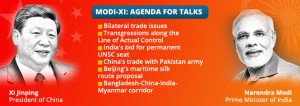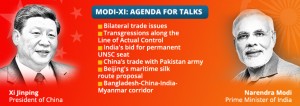Why Indo-China cooperation is a historical necessity for the Global Good?
Why is China so keen to build durable, economic and political relations with India and vice versa is a question everybody is asking in both the countries. Unfortunately, most people tend to see Indo-China relationship through simplistic lens of friends and foes, East and West and big and small. There is a very large constituency in India of bureaucrats, politicians and civil society members who believe that relationship with China is fraught with risks but with western countries, including USA, it is normal. They forget that 1965-67 when India was facing famine like situation in the aftermath of a severe drought and war with Pakistan, US had stopped the food aid under PL 480. Lal Bahadur Shastri then had to make an appeal to the countrymen not to eat grains on Monday evening so that existing stocks could help us in sailing through. Many of the younger people may not realize that almost the entire country accepted the advice of Shastri and rallied behind him. Again in 1971 when India supported Mukti Bahani for the independence of Bangladesh, US had again put sanctions against India. The seventh fleet of US navy was moved to Bay of Bengal. Despite such gestures, we have no compunction in treating US as a permanent friend. Indeed there is a lot that India and US have to share. I wish indo-US relations to improve and become stronger. But Indian and US interest dont have to collide with Indian and Chinese convergent interests. However, Indo-China relationships despite 1962 war and a large part of our territory being under Chinese occupation, have to be seen in the context of two great civilizational societies trying to come together.
When Indian Prime Minister visited Bhutan as the first nation to visit after the new government took over, he underlined the importance of peaceful relationship with China through prosperous and peaceful buffer nation like Bhutan. Indian look-east policy, enunciated by our present President, Shri. Pranab Mukherjee in his earlier avtar as Finance Minister is a viable, long overdue shift in our bias from west to east. There is no way India can build strong presence in south and south-east Asia without Chinese cooperation.
It might appear that Indian efforts to build bridges with Vietnam precisely at the time when Chinese President is visiting India is a provocation in the Chinese area of influence. This is not true. It is as plausible as Chinese investment in gaining access to Bay of Bengal through Myanmar, in an intimate area of Indian influence. China has 40 billion dollars surplus in trade. We export about 20 billion dollars worth of goods and services whereas China exports to India about 60 billion dollars. Russia has stood by India through thick and thin all these years and yet our trade with Russia is hardly 12 billion dollars. May be India-Russia-China axis is waiting to emerge. The economics of the modern age cannot be understood only through geo-political lens. China is looking at 100 billion dollars worth of investment opportunities in India to help Prime Minister of India operationalize his, ‘make in India’ dream. If Chinese can bring greater discipline and time-boundedness in large infrastructural projects [which in India almost always have had high time and cost over run], it will be a great service to Indian mindset, attitude and ability to take up bigger visions in future. China wants to learn from India the art of managing conflicts and tensions among various stakeholders peacefully and in an orderly manner by and large. China has had more strikes in the last six months in various manufacturing units than in the last six years. The rising income disparity and aspirations of Chinese workers demand new social contract within the framework of Chinese society. There are a few lessons to be learnt from India.
When Chinese President decides to visit Ahmedabad first and Delhi later, he is strengthening the Prime Minister’s vision of cementing federal structure. The partnership between Gujarat and Guangdong province of China is actually a merger of two high growth trajectories. Guangdong is one of the fastest growing province of China and Gujarat is of India. The partnership between these two states will signal a new mutual learning opportunity for both sides. It is not without significance that the strongest Honey Bee Network outside of India is in China. The last almost a decade of partnership between Tianjin University of Finance and Economics [TUFE], IIMA and Honey Bee Network has led to enormous capacity building in China for scouting, documenting and valorizing grassroots green innovations. China has done a great job in large scale technologies and social transformation. But, the fact that for some of the problems Chinese and Indian farmers and mechanics have had to invent similar solutions shows enormous opportunity for learning from each other. There is no point why two societies should rediscover the wheel.
In 2012, IIMA and TUFE jointly organized second International Conference on Creativity and Innovations at Grassroots [ICCIG] with one part held in China and another in India. In third ICCIG, being held at IIMA during January 19 – 22, 2015 a strong presence of Chinese delegation is expected. India has to learn the art of seamless scaling up of good ideas from China. China has to learn managing rising aspirations and increasing fragmentation in society through peaceful and non-violent means. India and China together can become harbinger of new model of development where large amount of knowledge and innovation public goods can be shared with the third world. It is not for nothing that large number of western companies are coming to India to learn about frugal innovations. The blending of frugal, flexible and friendly innovations with large scale application expertise of China will imply highly distributed and inclusive growth model. China has top 70 universities among 200 in BRICS countries. India can take a cue from here for improving higher education. China also has higher number of universities among the top 200 worldwide than India.
China has begun to develop stronger environmental management policies and in manufacturing strategies. There is much higher awareness about circular economy in China than in India. India has to tame its waste-oriented economic system and move towards circular economy. Chinese experience will come in handy. China has surpassed USA in both patents and quality publications. India has an ambition of improving its standing in this regard. Our partnership with Chinese academic institutions is extremely feeble and fragile. It needs a strong push.
Indo-China partnership like any other partnership will have points of tension , paradoxes and contradictions. But, the long heritage of Buddhist connection gives a hope that both societies will draw inspiration from the Buddhist policy of following a middle path. We must not interpret too much into small incidents on Indo-Chinese border. In a way, these are good for both sides to keep an agile readiness. But, both countries must enter into a kind of no-war pact backed up by institutionalized means of monitoring each other’s actions in sensitive areas so that the mutual trust is reinforced by adequate modern monitoring systems and mechanisms.
India should not ignore that Chinese President is not visiting Pakistan during his south-Asian tour. There are regions in China which are facing extremism exported through Pakistan. May be, it is a friendly signal by China to Pakistan that it should prevent use of Pakistani territory for export of terrorism to China. Increasing Chinese influence in Indian ocean should be seen at par with Indian effort to explore oil in southern China sea. Every country pursues its strategic interests and that is to be expected. What is special about the visit of the Chinese President, Mr. Xi Jinping to India is the strong desire on both the sides to become partner in the mutual inclusive growth story.
The sister relationship between two cities of Gujarat and Guangdong may remind some people of the unfortunate saga of Hindu-Chini bhai bhai. It is true that we have had a war in 1962. But the greater truth is that we have had peace on our border since then. The resolution of border issues will require give and take. China will abandon its claim on Arunachal Pradesh and India may have to abandon some of its claim in Aksai Chin.
Who gives more or less cannot be seen from a single prism or lens. There is a great deal to be gained through mutual cooperation for larger national, regional and global good. Indo-Chinese friendship can only bring a growth pull effect for the rest of the world given our size of respective markets. India will plead for higher market access and China will ask for greater investment opportunities. It is possible that both sides win not only their arguments but also respective hearts.


